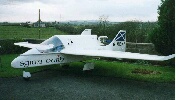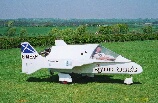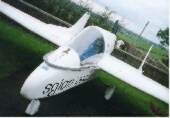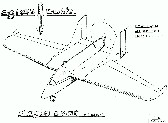Since
the introduction of the B.C.A.R. Section "S" in 1985 there have been no
new 3 axis microlights of British manufacture or design even taken to the
very rigourous test stage. It is my contention that the "Authorities"
can`t (or won`t) cope with anything new, they need a production status
aircraft with "history" before they will even consider looking at it.
 My first attempt at my own design was a two seat all flying canard called
the "IOLAIRE" (left) this met with nothing but blocking even after all
the structural stress calculations had been checked and the load testing
completed in line with B.C.A.R. Section "S" approved methodology.
It has flown, and proved stable and easy to handle, both in the air and
on the ground, however an approved flight test program cannot be conducted
without a TEST CERTIFICATE.
My first attempt at my own design was a two seat all flying canard called
the "IOLAIRE" (left) this met with nothing but blocking even after all
the structural stress calculations had been checked and the load testing
completed in line with B.C.A.R. Section "S" approved methodology.
It has flown, and proved stable and easy to handle, both in the air and
on the ground, however an approved flight test program cannot be conducted
without a TEST CERTIFICATE.
When I began to think about the design for a single seat microlight I went back to my aeromodelling roots (when I designed and raced FAI models at International level) and thought about the increase in speed and rigiditty the flying wing layout offered. So the idea for the SGIAN DUBH (pronounced skee an doo) came from a team racer. The name SGIAN DUBH translates from Gaelic (ancient Scots) for BLACK KNIFE, i.e. the old Highlander`s dagger hence the emblem on the nose.  Once I had more or less finalized the layout, I built a 1/4 scale radio
controlled model and put it through a fairly stiff program. The results
were very encouraging indeed. The stall was a non event, no adverse
yaw could be seen and, flying slow at tick-over RPM then applying full
power produced no negative pitching (the thrust line of the engine is aligned
with the wing C.of G. position). The landing flare was perfect.
I tried different strakes, but the results were inconclusive.
Once I had more or less finalized the layout, I built a 1/4 scale radio
controlled model and put it through a fairly stiff program. The results
were very encouraging indeed. The stall was a non event, no adverse
yaw could be seen and, flying slow at tick-over RPM then applying full
power produced no negative pitching (the thrust line of the engine is aligned
with the wing C.of G. position). The landing flare was perfect.
I tried different strakes, but the results were inconclusive.
The lack of downward vision always seemed to be a problem with wings so the pilot had to be out in front, therefore the engine was put in the correct place as a pusher. I had a spare Rotax engine so that was the one I used (447).  I used the NACA 23012 section because it has a nearly neutral pitching
moment, and more importantly I have the co-ordinates and some of the figures
for same. The extended centre section has a reflex from about 80%
chord with the T/E level with the section height. The ramp effect between
the extended fins should help with aero effect. The ailerons are
large with small movements and are differentialled 1:1.5. For the
first flights they will be set at about +3°. The rudders act
"out only" and have tip plates to help with rudder authority at low speeds
since they are outwith the propwash. As you can see from the photo
in the field (above), we were taxiing without the outer wing panels to
check out the undercarriage. After this test I molded a new, stiffer
undercarriage and a new nosewheel steering system.
I used the NACA 23012 section because it has a nearly neutral pitching
moment, and more importantly I have the co-ordinates and some of the figures
for same. The extended centre section has a reflex from about 80%
chord with the T/E level with the section height. The ramp effect between
the extended fins should help with aero effect. The ailerons are
large with small movements and are differentialled 1:1.5. For the
first flights they will be set at about +3°. The rudders act
"out only" and have tip plates to help with rudder authority at low speeds
since they are outwith the propwash. As you can see from the photo
in the field (above), we were taxiing without the outer wing panels to
check out the undercarriage. After this test I molded a new, stiffer
undercarriage and a new nosewheel steering system.
 The construction is the same as the IOLAIRE extruded polystyrene foam with
290t glass cloth and West System epoxy. All awkward contours, leading
edge D`s etc. were hot wired. The main spar is built up plywood to take
the mortice and tennon wing joints. The strakes round the lower edge
of the cockpit extend the " pitch platform " and are set at +1.5° covered
with carbon fibre.
The construction is the same as the IOLAIRE extruded polystyrene foam with
290t glass cloth and West System epoxy. All awkward contours, leading
edge D`s etc. were hot wired. The main spar is built up plywood to take
the mortice and tennon wing joints. The strakes round the lower edge
of the cockpit extend the " pitch platform " and are set at +1.5° covered
with carbon fibre.
 The tank is situated on the C.of G. Home designed and made prop and
undercarriage. The all-up-weight so far, with 86 kg pilot is around
266 kg. The side stick is a slider type and the same push rod operates
both elevators and ailerons. Right is an early cockpit view of the
SGIAN DUBH (no engine fitted at this stage).
The tank is situated on the C.of G. Home designed and made prop and
undercarriage. The all-up-weight so far, with 86 kg pilot is around
266 kg. The side stick is a slider type and the same push rod operates
both elevators and ailerons. Right is an early cockpit view of the
SGIAN DUBH (no engine fitted at this stage).
If you have comments or questions, you can contact
Hugh at: lorimer@alpbach2.fsnet.co.uk
|

